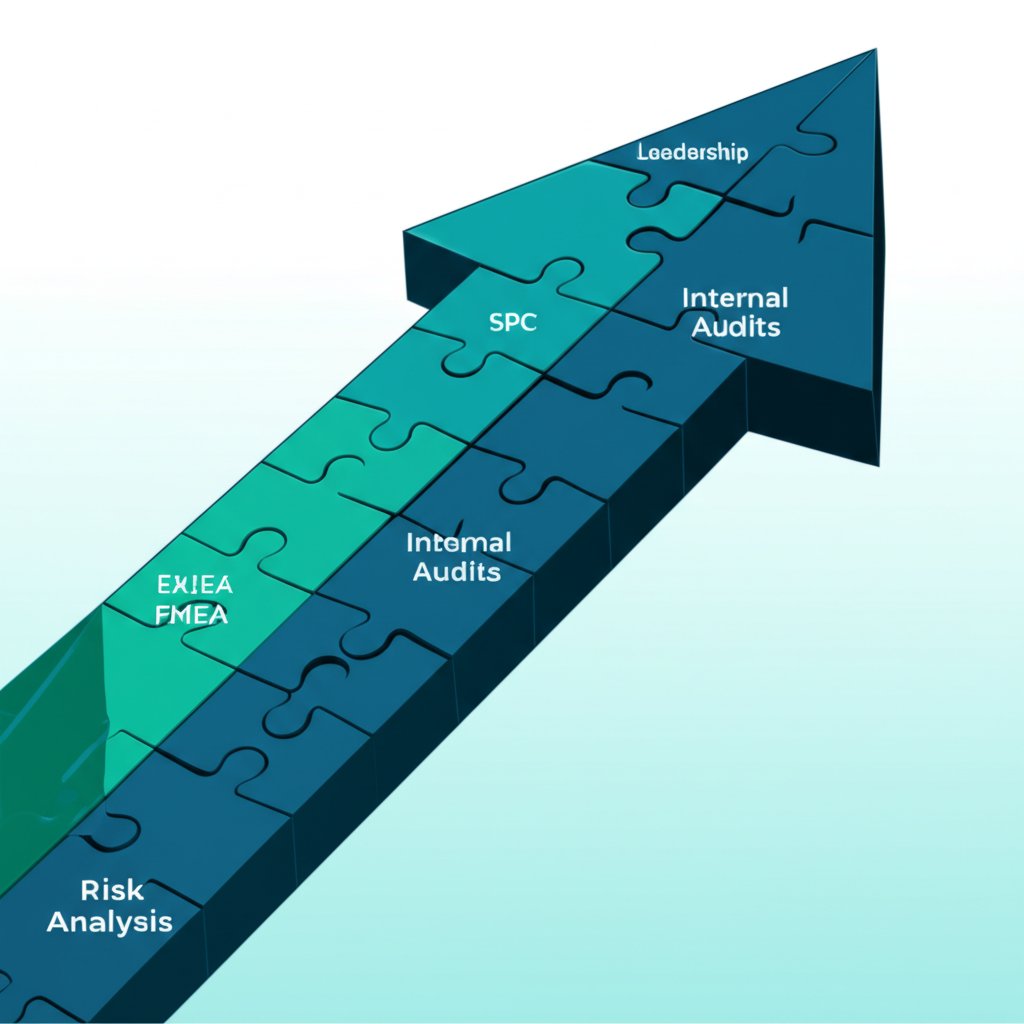The Core Role of a QMS for IATF 16949 Certification


TL;DR
The IATF 16949 standard establishes the mandatory requirements for a Quality Management System (QMS) within the global automotive industry. The primary role of a QMS in IATF 16949 is to serve as the operational framework that an organization uses to ensure product consistency, drive continual improvement, and fulfill the standard's core objectives: preventing defects and reducing variation and waste throughout the supply chain.
Defining the Foundations: What are IATF 16949 and a QMS?
In the automotive industry, precision, safety, and reliability are non-negotiable. To achieve this, the sector relies on a rigorous framework for quality. At the center of this framework are two distinct but inextricably linked concepts: IATF 16949 and the Quality Management System (QMS). Understanding their relationship is the first step toward achieving compliance and operational excellence.
IATF 16949 is the international technical specification and quality management standard for the automotive industry. Developed by the International Automotive Task Force (IATF), it is not a QMS itself but rather the definitive rulebook that outlines what an automotive QMS must achieve. It harmonizes the different assessment and certification systems in the global automotive supply chain, creating a single, clear set of requirements for suppliers. Importantly, IATF 16949 is not a standalone document; it must be implemented as a supplement to and in conjunction with ISO 9001:2015, which provides the foundational requirements for any QMS.
A Quality Management System (QMS), on the other hand, is the specific set of policies, processes, procedures, and records that an organization implements to meet customer and regulatory requirements. It is the practical, operational framework a company builds and uses daily. A QMS defines how an organization ensures its products and services are consistent, reliable, and of high quality. While a QMS can exist in any industry, in the automotive sector, an effective QMS must be designed and operated to meet the stringent criteria laid out by IATF 16949.
The fundamental difference lies in their roles: IATF 16949 is the 'what'—it defines the requirements and objectives. The QMS is the 'how'—it is the living system an organization creates to execute on those requirements. An organization cannot be certified to a QMS, but it can achieve certification to the IATF 16949 standard by demonstrating that its QMS is fully compliant with all specified clauses.
The Core Function: How a QMS Fulfills IATF 16949 Requirements
A Quality Management System is the engine that drives an organization toward IATF 16949 compliance. It translates the standard's abstract requirements into concrete actions and measurable outcomes. The QMS serves as the central, integrated system for managing all aspects of quality, from initial product design to final delivery and service. Its role is multifaceted, touching every part of the organization to ensure a unified approach to quality.
The primary functions of a QMS in the context of IATF 16949 include:
- Ensuring Consistent Quality and Product Safety: A QMS establishes standardized processes and work instructions to ensure that every product is manufactured to the same specifications, consistently meeting customer and safety requirements.
- Driving Process Control and Efficiency: It provides the tools and methodologies to monitor, measure, and control manufacturing processes, leading to greater efficiency and resource effectiveness.
- Managing Supply Chain Variation: The standard places heavy emphasis on the entire supply chain. A compliant QMS includes robust processes for supplier selection, monitoring, and development to reduce variation and waste originating from external providers.
- Facilitating Risk Management and Compliance: A QMS is built around a risk-based thinking approach, helping organizations identify, assess, and mitigate risks related to product quality, safety, and regulatory compliance.
By implementing these functions, the QMS becomes more than a set of documents; it becomes a dynamic tool for performance management. It provides the structure for collecting data, analyzing performance, and making evidence-based decisions. This systematic approach ensures that the organization not only meets the baseline requirements of IATF 16949 but also builds a resilient operational model capable of adapting to changing customer demands and market conditions.

Key Pillars of an IATF-Compliant QMS: Processes and Objectives
The IATF 16949 standard is built on several core principles that a QMS must bring to life. These pillars move beyond simple compliance and aim to create a culture of excellence. The three most critical objectives are defect prevention, the reduction of variation and waste, and a commitment to continual improvement. A robust QMS provides the specific processes and tools needed to achieve these goals.
Defect prevention is a cornerstone of IATF 16949, shifting the focus from detection to proactive avoidance of non-conformities. An effective QMS embeds this philosophy through structured tools like Advanced Product Quality Planning (APQP) and Failure Mode and Effects Analysis (FMEA). APQP ensures that quality is planned into the product and process design from the very beginning, while FMEA is used to systematically identify potential failure modes and implement controls to prevent them from occurring. This proactive stance minimizes costly rework, scrap, and customer complaints.
The second pillar is the relentless reduction of variation and waste in the supply chain. Variation in processes or components leads to inconsistent product quality, while waste consumes resources without adding value. A QMS addresses this through methodologies like Statistical Process Control (SPC) and Measurement Systems Analysis (MSA). SPC uses statistical data to monitor and control processes, while MSA ensures that the measurement systems used to gather that data are accurate and reliable. Managing the supply chain is also critical here. For automotive projects demanding precision-engineered components, sourcing custom aluminum extrusions from a provider with a certified IATF 16949 system, like Shaoyi Metal Technology, ensures that parts meet exact specifications, directly contributing to the reduction of variation in the final assembly.
Finally, continual improvement is not just a goal but a mandatory, ongoing activity. The QMS facilitates this through structured processes for internal audits, management reviews, and corrective actions. Internal audits verify that the QMS is functioning as intended, while management reviews ensure that top leadership is actively engaged in assessing performance and directing improvement efforts. When problems do arise, a formal problem-solving and root cause analysis process ensures that they are not only fixed but that systemic changes are made to prevent recurrence.
Strategic Alignment: From QMS Implementation to IATF 16949 Certification
Achieving IATF 16949 certification is a strategic endeavor that requires aligning an organization's QMS with the rigorous demands of the standard. This process goes beyond merely writing procedures; it involves embedding a quality-focused mindset throughout the organization, championed by top management and embraced by every employee. The journey from implementation to certification is a structured path that transforms how a company operates.
The first critical element is leadership commitment. IATF 16949 explicitly requires top management to be accountable for the effectiveness of the QMS. This means leaders must not only provide resources but also actively participate in setting quality objectives, reviewing system performance, and fostering a culture where quality is everyone's responsibility. Without this visible and sustained support from the top, any QMS implementation is likely to fall short.
Next is the thorough documentation and control of processes. An IATF-compliant QMS requires clear, documented information for all key processes, from design and development to production and post-delivery activities. This includes control plans, work instructions, and records that provide evidence of conformity. Modern requirements management tools can be invaluable in maintaining tight control over requirements, managing changes, and ensuring traceability, which are foundational to a robust QMS.
The audit trail is the final preparatory step before certification. Organizations must conduct comprehensive internal audits of their QMS, manufacturing processes, and products to verify compliance and identify areas for improvement. These internal assessments prepare the organization for the rigorous external audit conducted by a third-party certification body, such as NSF. Successfully passing this two-stage audit—which includes a readiness review and an on-site certification audit—results in IATF 16949 certification, signaling to the global automotive industry that the organization's QMS meets the highest standards of quality.

Beyond Compliance: A Culture of Quality
Ultimately, the role of a Quality Management System in IATF 16949 extends far beyond achieving a certificate for the wall. It is about fundamentally transforming an organization's approach to its operations. A well-implemented QMS instills a culture of continual improvement, risk-based thinking, and unwavering customer focus that becomes integral to the company's identity and success.
Implementing a QMS to meet IATF 16949 requirements forces an organization to scrutinize its processes, eliminate waste, and build efficiency into every activity. This leads to tangible business benefits, including improved customer satisfaction, increased productivity, and enhanced credibility in the marketplace. It provides a common language and framework for quality that aligns internal teams and the entire supply chain toward a shared goal.
In the competitive and safety-critical automotive sector, a compliant QMS is not just a requirement but a strategic asset. It provides the structure needed to consistently deliver high-quality products, manage complex supply chains, and adapt to the industry's ever-evolving demands, ensuring long-term viability and growth.
Frequently Asked Questions
1. Is IATF 16949 a quality management system?
No, IATF 16949 is not a Quality Management System (QMS) itself. It is an international technical standard that defines the specific requirements for a QMS in the automotive industry. Organizations develop and implement their own QMS to meet the criteria set forth by the IATF 16949 standard in conjunction with ISO 9001.
2. What is the difference between QMS and IATF 16949?
The key difference is that a QMS is the set of internal processes, policies, and procedures an organization uses to manage quality, while IATF 16949 is the external standard that specifies what those processes must achieve. Think of IATF 16949 as the blueprint and the QMS as the actual system built from that blueprint. IATF 16949 provides the rules; the QMS is how an organization follows them.
3. What is the main purpose of a quality management system (QMS)?
The main purpose of a QMS is to ensure an organization can consistently meet customer requirements and enhance customer satisfaction. It achieves this by establishing a framework of business processes focused on consistency, efficiency, and continual improvement. In the context of IATF 16949, this purpose is sharpened to include specific goals like defect prevention and the reduction of waste and variation in the automotive supply chain.
4. What is the role of a QMS for effective regulatory compliance?
A QMS plays a critical role in regulatory compliance by providing a structured and systematic approach to meeting legal and statutory requirements. It ensures that compliance-related activities are defined, controlled, and documented. For the automotive industry, this includes requirements related to product safety, environmental regulations, and material reporting, which are integral parts of the IATF 16949 standard.
 Small batches, high standards. Our rapid prototyping service makes validation faster and easier —
Small batches, high standards. Our rapid prototyping service makes validation faster and easier — 
